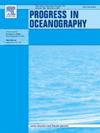通过单箱和三箱反演模式估算2021年北大西洋副热带环流西侧纬向流
IF 3.6
3区 地球科学
Q1 OCEANOGRAPHY
引用次数: 0
摘要
北大西洋西部副热带环流由温暖的墨西哥湾流(GS)和寒冷的深西边界流(DWBC)组成,它们是大西洋经向翻转环流(AMOC)的主要气流。在北大西洋副热带环流(NASG)西部66°W (A22)和52°W (A20)的水文剖面分别于1997年、2003年、2012年和2021年对这些洋流进行了采样。使用单箱和三箱反演模型计算2021年水文数据的质量、热量和淡水输运,方法之间没有显著差异。研究表明,与2012年春季和1997年夏季相比,2021年春季在52°W和66°W的GS质量输运发生了实质性变化,但与2003年秋季相比没有变化。相反,DWBC在2021年春季和之前的巡航之间没有显着变化。此外,A20剖面采样的北巴西流物质输运呈现出先前所示的下游减弱。热通量和淡水通量与零没有显著差异,因此A20和A22剖面封闭的水量不能反映2021年的净海气通量。虽然GS表现出年代际变率,但该地区在一段时间内缺乏其他变化,表明环境和强迫条件总体上是稳定的。本研究强调了西南海区西部主要AMOC流(特别是GS和DWBC)持续的物质输送,强调了它们在更广泛的气候和海洋学过程中的稳定性和重要性。本文章由计算机程序翻译,如有差异,请以英文原文为准。
Estimating the western North Atlantic Subtropical Gyre zonal currents in 2021 through single- and three-box inverse models
The western North Atlantic Subtropical Gyre comprises the warm Gulf Stream (GS) and the cold Deep Western Boundary Current (DWBC), which are the main currents of the Atlantic Meridional Overturning Circulation (AMOC). Hydrographic sections conducted at 66°W (A22) and 52°W (A20) in the western North Atlantic Subtropical Gyre (NASG) have sampled these currents in 1997, 2003, 2012, and 2021. Both single- and three-box inverse models are used to compute mass, heat, and freshwater transport to the hydrographic data of 2021 with no significant differences between methodologies. This study reveals a substantial change in the GS mass transport at both 52°W and 66°W in spring 2021 compared to spring 2012 and summer 1997, but no changes compared to fall 2003. Conversely, the DWBC shows no significant modification between spring 2021 and previous cruises. Moreover, the North Brazil Current mass transport, which is sampled by the A20 section, presents the downstream weakening showcased previously. Heat and freshwater fluxes are not significantly different from zero, therefore the water volumes enclosed by the A20 and A22 sections do not reflect a net air-sea flux in 2021. Although the GS exhibits interdecadal variability, the lack of other changes over time in this area suggests a general stability in the environmental and forcing conditions. This study highlights the consistent mass transports of the main AMOC currents in the western NASG, particularly the GS and DWBC, emphasizing their stability and importance in broader climate and oceanographic processes.
求助全文
通过发布文献求助,成功后即可免费获取论文全文。
去求助
来源期刊

Progress in Oceanography
地学-海洋学
CiteScore
7.20
自引率
4.90%
发文量
138
审稿时长
3 months
期刊介绍:
Progress in Oceanography publishes the longer, more comprehensive papers that most oceanographers feel are necessary, on occasion, to do justice to their work. Contributions are generally either a review of an aspect of oceanography or a treatise on an expanding oceanographic subject. The articles cover the entire spectrum of disciplines within the science of oceanography. Occasionally volumes are devoted to collections of papers and conference proceedings of exceptional interest. Essential reading for all oceanographers.
 求助内容:
求助内容: 应助结果提醒方式:
应助结果提醒方式:


